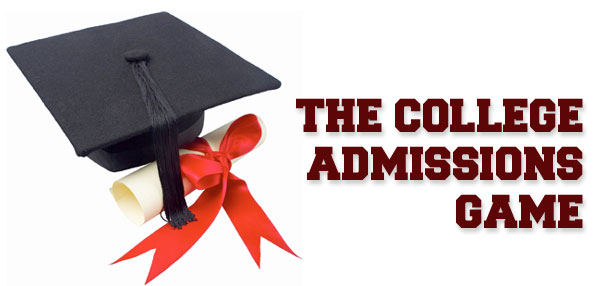 College admissions officers have been criticized about things like caps on Asians Americans and decisions about who gets in and who does not. But what do they really think? The Daughter’s high school held a session where a college admissions officer talked about admissions from the his perspective and gave us parents a chance to ask him questions. This segment presents a view of the admissions game from the other side. The admissions officer, the Dean of Admissions from a small San Francisco Bay Area private university, talked about trends, tricks, and test scores in today’s world of college admissions.
College admissions officers have been criticized about things like caps on Asians Americans and decisions about who gets in and who does not. But what do they really think? The Daughter’s high school held a session where a college admissions officer talked about admissions from the his perspective and gave us parents a chance to ask him questions. This segment presents a view of the admissions game from the other side. The admissions officer, the Dean of Admissions from a small San Francisco Bay Area private university, talked about trends, tricks, and test scores in today’s world of college admissions.
Here is a summary of what he talked about. I occasionally intersperse my opinion among his comments.
Trends: College Slots Down, Competition Up, and Tests Out
As the University of California and California State college systems deteriorate, with UC cutting enrollment by 1500 and Cal State looking at cutting up to 40,000, more and more students are turning to private schools. At his college, admissions became much more competitive with yield (the number of admissions who accept) going up and no one being taken off of the waiting list. Despite this situation with public colleges helping out his college, he felt bad that the implementation of the California master plan for higher education, a jewel of California and a plan copied by many other public university systems, has been allowed to deteriorate this much.
Another consequence of UC and Cal State system problems is that these schools have an incentive to recruit more students from out of state. These students pay a much higher tuition rate, and the money that they pay stays on each campus. The UC campuses funded by California tax payers then get to be used by people from out of state. Sad.

Carl Brigham originated the SAT as an “objective” test that would exclude Southern Europeans, African Americans, and other groups of what he considered lower Intelligence from Princeton University. He later repudiated these views, but not after his writings on the subject influenced anti-immigration legislation and the eugenics movement. Ironically, the SAT was picked up by Harvard as a more egalitarian way to select scholarship recipients and grew to be used beyond Harvard. Source: Frontline: Secrets of the SAT
In terms of admissions, he mentioned that more and more colleges were dropping test scores as a requirement. He pointed out that SAT test scores correlate strongly to family income and tossed out an example of a how Filipino first generation student where English is spoken intermittently at home would probably not score as well on English verbal tests as well as a white student whose family has been here for several generations. Also, as competition gets more intense, he said that more and more criteria is going to be subjective.
While I can I understand these trends – I can see how wealthier families could afford test prep classes and how when you have lots of high achievers with similar scores, you need other more subjective factors as tie breakers – I don’t think that this bodes well for Asian American students. “Subjective Criteria” have been used as an admissions barrier in the past against Jews and against Asian Americans. Regarding test scores, correlation is not causation, and correlation is not destiny – individuals can achieve different results uncorrelated to their family income (for better and for worse effect). The SAT test as a college admissions criteria is an ironic creation when it comes to the idea of its original intended purpose (see box).
Some Recommendations: Early Action, Stay in Touch
So what should students do in the changing world of admissions? The Admissions Dean made a number of recommendations. He said that you might consider applying to colleges in area of declining population as they might offer additional incentives to applicants. Early Action (applying early and asking for an early decision with no commitment) is good idea. If a student thinks that he or she has a good chance of getting in, then that student should apply Early Action. With the trends discussed above, the number of applications to colleges, especially compared the number of available slots is not going to go down, so get in while you can. In addition to Early Action, getting all of one’s application materials, including all supporting forms, submitted early is a good idea, and this tends to reduce problems and gives you time to fix problems if they do occur.
Other recommendations are to let admissions officers know you are interested. You can let them know not just by applying, but by going to events that college hold where you can meet admissions officers and let them know you want in. That last recommendation kind of rubs me the wrong way – you need to “schmooze” admissions officers to improve your chances?
Final Comment: It will Probably Work Out
Despite all of the above, he said that most students get into their first choice college. I interpreted this message as don’t stress and obsess (a sentiment perhaps aimed at the many Asian American parents in the audience) as the college selection usually works out.
Tune in for Part 4: The School Visit.








